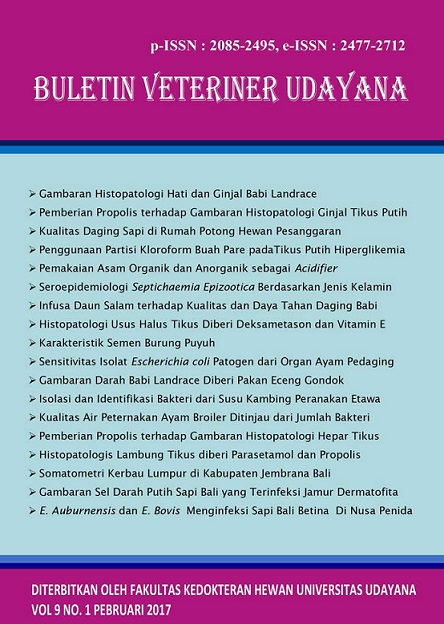CHARACTERISTICS OF THE QUAIL CEMENT
Abstract
This study aims were to investigate the characteristics of the quail cement macroscopically and microscopically. The research used 30 quail with ± 6 weeks of age as a source of cement. The quail cement collection were done by using modifications of massage technique to prevent contamination of the foam produced by cloaca gland and feces. Examination of cement macroscopically include volume, color, pH and consistency (viscosity) and microscopic examination includes sperm concentration, morphology, abnormalities , the number of live sperm and sperm motility. The results showed that the quail cement (Coturnix-Coturnix Japonic) macroscopically has a ±0.02 ml of volume, beige, pH ±7.06, lumpy consistency and a distinctive odor, while the results of microscopic examination of quail has a mass wave of spermatozoa good (++), ±86% progressive motility, sperm concentration ±57.2x107, spermatozoa abnormalities ±7.4% and ±5% spermatozoa death.
Downloads
References
Baumgartner J. 1990. Prepelica japonska ako laboratorne zviera. Veterinarstvo Serie C: 70-72. (in Slovakian).
Bunaciu M, Bunaciu P, Cimpeanu I. 1994.The influence of mating designed on the reproductive performance in Japanese quail. Proc 9th. European Poultry Conference Glasgow 1: 314-316.
Burrows WH, Quinn JP. 1937. The Collection Of Spermatozoa From The Domestic Fowl and Turkey. Poult Sci 16: 19-24.
Buxton JR, Orcutt Jr FS. 1975. Enzymes and electrolytes in the semen of Japanese quail. Poult Sci 54: 1556-1566.
Chelmonska B, Jerysz A, Lukaszewich E, Kowalczyk A. 2006. The effect of proctodeal gland, diluent and dimethylacetamide addition on morphology and fertillising ability of japanese quail (Coturnix coturnix Japonica) spermatozoa. Poult Sci 43: 54-59.
Chelmonska B, JeryszA, Lukaszewich E, Malecki I. 2008. Semen collection from japanese quail (Coturnix coturnix japonica) using a teaser female. J Vet Anim Sci 32(1): 19-24.
Everet RW, Bean. 1982. Environmental influence on semen output. J Dairy Sci 65: 1303-1310.
Fujihara N, Koga O. 1991.Physiological function of the dorsal proctodeal gland foam of the male quail. Proc.World Quail Conference Estonia pp: 78-83.
Hafez ESE, Hafez B. 2000. Transport and survival of gametes. In: Reproduction in farm animal. 7th Ed. Kiawah Island, South Carolina, USA.
Handarini R, Saleh E, Togatorop B. 2008. Produksi Burung Puyuh yang Diberi Ransum Dengan Penambahan Tepung Umbut Sawit Fermentasi. Agribisnis Peternakan 4(3): 107-110.
Indrawati D, Bebas W, Trilaksana IGNB. 2013. Motilitas dan daya hidup spermatozoa ayam kampung dengan penambahan astaxanthin pada suhu 3-5oC. Indon Med Vet 2(4): 445-452.
Panekenan JO, Loing JC, Rorimpandey B, Waleleng POV. 2013. Analisis keuntungan usaha beternak puyuh di Kecamatan Sonder Kabupaten Minahasa. J Zootek 32(5): 1-10.
Ricker JV. 2006. Equine sperm membrane phase behavior: the effects of lipid-based cryoprotectants. Biol Reprod 74: 359-365.
Situmorang R, Bebas W, Trilaksana IGNB. 2014. kualitas semen ayam kampung pada suhu 3-5oC pada pengenceran fosfat kuning telur dengan penambahan laktosa. Indon Med Vet 3(4): 259-265.
Sujoko H, Setiadi MA, Boediono. 2009. Seleksi spermatozoa domba garut dengan metode sentrifugasi gradien densitas percoll. J Vet 10(3): 125-132.
Tarasewicz Z, Udala J, Szczerbinska D, Danczak A, Romaniszyn K. 1997.Quality of semen and selected testimetric features in male Japanese quails. Anim Reprod Rev 31: 179-184.
Tetty. 2002. Puyuh si mungil penuh potensi. Agro Media Pustaka. Jakarata.
Toelihere MR. 1985. Fisiologi reproduksi ternak. Angkasa, Bandung.
Toelihere MR. 1993. Inseminasi buatan pada ternak. Angkasa, Bandung.
Yudin AI, Tollner TL, Treece CA, Kays R, Cherr GN, Overstreet JW, Bevins CL. 2008. Β-Defensin 22 is a major component of the mouse sperm glycocalyx. Reprod 136(6): 753-765.





